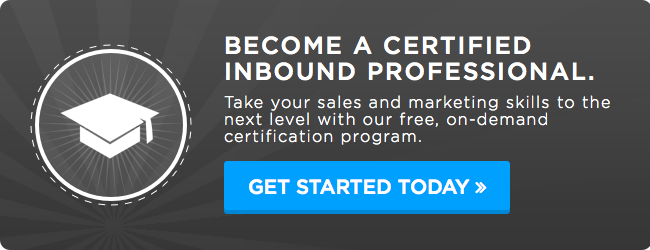 Inbound isn’t all about marketing. After all, what happens to all those leads you’ve been getting? Your business can’t run on leads alone -- you need customers who help bring in revenue and fuel your future inbound strategies.
Inbound isn’t all about marketing. After all, what happens to all those leads you’ve been getting? Your business can’t run on leads alone -- you need customers who help bring in revenue and fuel your future inbound strategies.

So once you’ve perfected your visit-to-lead acquisition, it’s time to get to work on your lead-to-customers game. Below are some of my favorite tactics that inbound marketers and salespeople alike can use to help nurture and close more leads into customers.
Target your email sends.
How many times have you received an email from a company you’ve never even heard of? What about an email with a subject line that says something along the lines of “Get a great deal on our product!” from a site you just visited for the first time? And how many times have you actually liked those emails and continued to open more like them in the future?
If you said something along the lines of “oh gosh I hate those emails why are you reminding me about them,” you’re not alone. Emails that are either wholly irrelevant to their recipients -- or irrelevant to where those recipients happen to be in the buyer’s journey -- can not only annoy your potential customers, but in fact make it less likely they’ll want to do business with you in the future.
Now let’s switch gears a bit: Think about the last time you received an email directly related to a piece of content you downloaded or an offer you signed up for, or one that offers an answer to the question you’ve been trying to figure out all week. Did you open that email? Chances are good you did.
It’s easy to see why emails specifically targeted to recipients’ needs and interests are much more likely to be opened, but even emails with subject lines like the “get a great deal!” one mentioned above can garner a plethora of clicks if it’s sent to the right person at the right time -- like a contact who is in the decision stage of the buyer’s journey. Sending emails tailored to deliver exactly the right message at the right time immediately build recipients’ trust in your organization and make it more likely they’ll continue to engage with you in the future.
Think about email as a tool for building relationships with your leads. The more you position yourself as a consultant within your emails -- ready to help your prospects with their challenges -- the more likely they will interact with you.
Personalization is the magic word.
What do you see when you visit a website like Amazon or Netflix? Probably something different than what your coworker, friend, or relative sees. These websites make the effort (and use the data) to better understand their visitors’ likes and interests and create a personalized website experience.
These companies’ use of personalization goes a long way toward building trust with their website visitors -- and makes it more likely that those visitors will think of Amazon or Netflix next time they’re interested in buying a product or watching a movie.
While you’ll need to use smart content to create a personalized website, you can easily integrate this level of personalized messaging into your emails using personalization tokens. These tokens are small fragments of text you can place into your emails that pull in information your contacts have provided about themselves. Personalization tokens can be used to customize your email’s subject line or body to include the recipient’s specific company size, industry, location, title, or otherwise. Using these tokens can go a long way toward transforming each email you send into a sales-generating tool.
Here’s a real-life of example of how email personalization can work to generate sales. Two months ago, I bought a 30-day supply of protein powder from Amazon.com. Just as my protein powder supply starts to dwindle, Amazon sends me an email asking: “Have you bought your protein powder this month? Check out similar flavors that might interest you!” Amazon instantly hooks me and gets my business yet again.
Align your sales and marketing teams.
“Our sales team is lazy,” says a marketing specialist.
“Our marketing team is irrelevant,” says a sales rep.
Sound familiar? No matter which side of the equation you’re on, chances are you’ve heard one of those two lines spoken before. You’re not alone -- in fact, according to a study done by the Corporate Executive Board, 87% of the terms sales and marketing use to describe each other are negative.
A study by the Aberdeen Group, however, showed that companies with strong sales and marketing alignment get 20% annual revenue growth. Imagine that: 20% growth simply from collaborating with your coworkers!
It pays off for both teams to not only get along, but actively work together toward accomplishing overall company goals. By collaborating and removing the negativity between the two teams, companies can actively close more leads into customers. So if you’re not already getting together on a regular basis, schedule a meeting between your sales and marketing team leaders and take the first leap into aligning to better each other and your company as a whole.
Be an open book & leverage the buyer’s context in the sales process.
Not only has inbound transformed the way we market, it has also transformed the way sell. While the sales process used to consist of weeks upon weeks of cold calls and static pitches, today’s sales process is on the buyer’s schedule and must be tailored to their specific needs and wants. Instead of salespeople acting as the gatekeepers to content and information about products and services, we make that content readily available on our websites for prospects to download and access on their own. Gone are the days where sales rep hold the power in the buying process. Now, the tides have turned and the buyers have all the control.
In order to succeed with sales in an inbound world, sales reps must be open books -- ready and waiting to provide helpful information to their prospects and customers. Your potential customers can see right through generic scripts or stagnant sales pitches, so don’t be a machine! Breathe some life into your sales process by listening to potential buyers, tailoring sales pitches to each individual and their unique context, being helpful, and always keeping conversations relevant and personalized.
Determine the goal of a call before picking up the phone.
To all the sales reps reading, we get it. You have an ambitious activity number to hit and reaching it can be more than a little stressful. But, that’s no excuse for poor sales tactics. To get the most out of each call -- and to set each one up for success -- always determine the goal of each one of your sales calls before picking up the phone. Research prospects so that when you get the chance to interact with them, you’re prepared and able to have the conversation that’s most relevant to where they are in the buyer’s journey and who they are as people.
Beyond understanding both who your prospects are and what you’d like to accomplish when speaking to them on the phone, it’s important to make sure you know who you’re actually going to be speaking with and how that may influence your goal. Maybe you're calling someone to make an introduction, maybe you have the decision maker's name and number and you're calling to make the sale, or maybe you're just trying to get an internal or external referral. Regardless of the situation, the goal of the call will depend on who you're talking to and where they are in the buying cycle.
The inbound methodology doesn’t end after “convert.” In order to be truly successful with your inbound strategy, you need to effectively close your leads into customers. To dive deeper into how to maximize your customer generation efforts, check out HubSpot Academy’s Inbound Certification.

![Email Deliverability: 5 Quick & Effective Ways to Increase It [+IG]](https://blog.hubspot.com/hubfs/email-deliverability-1.jpg)

![What to Do When Leads Go Cold [Flowchart]](https://blog.hubspot.com/hubfs/sales_lead_gone_quiet.jpg)





